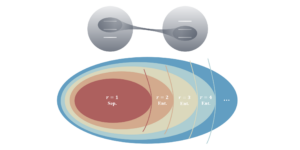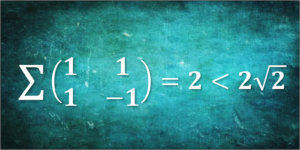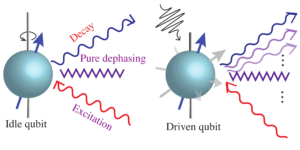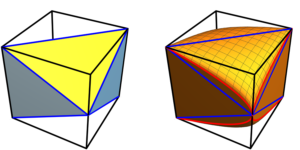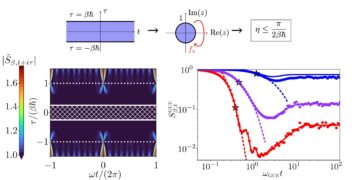1Institute for Theoretical Physics, Heinrich Heine University Düsseldorf, D-40225 Düsseldorf, Germany
2Institute for Quantum-Inspired and Quantum Optimization, Hamburg University of Technology, D-21079 Hamburg, Germany
Find this paper interesting or want to discuss? Scite or leave a comment on SciRate.
Abstract
The advantage that quantum systems provide for certain quantum information processing tasks over their classical counterparts can be quantified within the general framework of resource theories. Certain distance functions between quantum states have successfully been used to quantify resources like entanglement and coherence. Perhaps surprisingly, such a distance-based approach has not been adopted to study resources of quantum measurements, where other geometric quantifiers are used instead. Here, we define distance functions between sets of quantum measurements and show that they naturally induce resource monotones for convex resource theories of measurements. By focusing on a distance based on the diamond norm, we establish a hierarchy of measurement resources and derive analytical bounds on the incompatibility of any set of measurements. We show that these bounds are tight for certain projective measurements based on mutually unbiased bases and identify scenarios where different measurement resources attain the same value when quantified by our resource monotone. Our results provide a general framework to compare distance-based resources for sets of measurements and allow us to obtain limitations on Bell-type experiments.
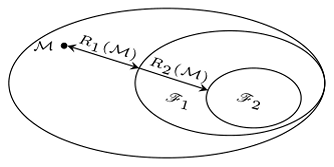
Popular summary
► BibTeX data
► References
[1] A. Einstein, B. Podolsky, and N. Rosen, Can quantum-mechanical description of physical reality be considered complete?, Phys. Rev. 47, 777 (1935).
https://doi.org/10.1103/PhysRev.47.777
[2] J. S. Bell, On the Einstein Podolsky Rosen paradox, Physics Physique Fizika 1, 195 (1964).
https://doi.org/10.1103/PhysicsPhysiqueFizika.1.195
[3] H. P. Robertson, The uncertainty principle, Phys. Rev. 34, 163 (1929).
https://doi.org/10.1103/PhysRev.34.163
[4] J. Preskill, Quantum computing 40 years later (2021), arXiv:2106.10522.
arXiv:arXiv:2106.10522
[5] C. L. Degen, F. Reinhard, and P. Cappellaro, Quantum sensing, Rev. Mod. Phys. 89, 035002 (2017).
https://doi.org/10.1103/RevModPhys.89.035002
[6] S. Pirandola, U. L. Andersen, L. Banchi, M. Berta, D. Bunandar, R. Colbeck, D. Englund, T. Gehring, C. Lupo, C. Ottaviani, J. L. Pereira, M. Razavi, J. S. Shaari, M. Tomamichel, V. C. Usenko, G. Vallone, P. Villoresi, and P. Wallden, Advances in quantum cryptography, Adv. Opt. Photon. 12, 1012 (2020).
https://doi.org/10.1364/AOP.361502
[7] R. Horodecki, P. Horodecki, M. Horodecki, and K. Horodecki, Quantum entanglement, Rev. Mod. Phys. 81, 865 (2009).
https://doi.org/10.1103/RevModPhys.81.865
[8] O. Gühne and G. Tóth, Entanglement detection, Physics Reports 474, 1 (2009).
https://doi.org/10.1016/j.physrep.2009.02.004
[9] R. Gallego and L. Aolita, Resource theory of steering, Phys. Rev. X 5, 041008 (2015).
https://doi.org/10.1103/PhysRevX.5.041008
[10] D. Cavalcanti and P. Skrzypczyk, Quantum steering: a review with focus on semidefinite programming, Reports on Progress in Physics 80, 024001 (2016a).
https://doi.org/10.1088/1361-6633/80/2/024001
[11] R. Uola, A. C. S. Costa, H. C. Nguyen, and O. Gühne, Quantum steering, Rev. Mod. Phys. 92, 015001 (2020a).
https://doi.org/10.1103/RevModPhys.92.015001
[12] N. Brunner, D. Cavalcanti, S. Pironio, V. Scarani, and S. Wehner, Bell nonlocality, Rev. Mod. Phys. 86, 419 (2014).
https://doi.org/10.1103/RevModPhys.86.419
[13] J. I. de Vicente, On nonlocality as a resource theory and nonlocality measures, Journal of Physics A: Mathematical and Theoretical 47, 424017 (2014).
https://doi.org/10.1088/1751-8113/47/42/424017
[14] D. Cavalcanti and P. Skrzypczyk, Quantitative relations between measurement incompatibility, quantum steering, and nonlocality, Phys. Rev. A 93, 052112 (2016b).
https://doi.org/10.1103/PhysRevA.93.052112
[15] S.-L. Chen, C. Budroni, Y.-C. Liang, and Y.-N. Chen, Natural framework for device-independent quantification of quantum steerability, measurement incompatibility, and self-testing, Phys. Rev. Lett. 116, 240401 (2016).
https://doi.org/10.1103/PhysRevLett.116.240401
[16] L. Tendick, H. Kampermann, and D. Bruß, Quantifying necessary quantum resources for nonlocality, Phys. Rev. Research 4, L012002 (2022).
https://doi.org/10.1103/PhysRevResearch.4.L012002
[17] A. Streltsov, H. Kampermann, S. Wölk, M. Gessner, and D. Bruß, Maximal coherence and the resource theory of purity, New J. Phys. 20, 053058 (2018).
https://doi.org/10.1088/1367-2630/aac484
[18] A. Streltsov, G. Adesso, and M. B. Plenio, Colloquium: Quantum coherence as a resource, Rev. Mod. Phys. 89, 041003 (2017).
https://doi.org/10.1103/RevModPhys.89.041003
[19] A. Bera, T. Das, D. Sadhukhan, S. S. Roy, A. Sen(De), and U. Sen, Quantum discord and its allies: A review of recent progress, Reports on Progress in Physics 81, 024001 (2017).
https://doi.org/10.1088/1361-6633/aa872f
[20] K.-D. Wu, T. V. Kondra, S. Rana, C. M. Scandolo, G.-Y. Xiang, C.-F. Li, G.-C. Guo, and A. Streltsov, Operational resource theory of imaginarity, Phys. Rev. Lett. 126, 090401 (2021).
https://doi.org/10.1103/PhysRevLett.126.090401
[21] O. Gühne, E. Haapasalo, T. Kraft, J.-P. Pellonpää, and R. Uola, Incompatible measurements in quantum information science (2021),.
https://doi.org/10.1103/RevModPhys.95.011003
[22] M. Oszmaniec, L. Guerini, P. Wittek, and A. Acín, Simulating positive-operator-valued measures with projective measurements, Phys. Rev. Lett. 119, 190501 (2017).
https://doi.org/10.1103/PhysRevLett.119.190501
[23] L. Guerini, J. Bavaresco, M. T. Cunha, and A. Acín, Operational framework for quantum measurement simulability, Journal of Mathematical Physics 58, 092102 (2017).
https://doi.org/10.1063/1.4994303
[24] P. Skrzypczyk and N. Linden, Robustness of measurement, discrimination games, and accessible information, Phys. Rev. Lett. 122, 140403 (2019).
https://doi.org/10.1103/PhysRevLett.122.140403
[25] K. Baek, A. Sohbi, J. Lee, J. Kim, and H. Nha, Quantifying coherence of quantum measurements, New J. Phys. 22, 093019 (2020).
https://doi.org/10.1088/1367-2630/abad7e
[26] E. Chitambar and G. Gour, Quantum resource theories, Rev. Mod. Phys. 91, 025001 (2019).
https://doi.org/10.1103/RevModPhys.91.025001
[27] R. Uola, T. Kraft, J. Shang, X.-D. Yu, and O. Gühne, Quantifying quantum resources with conic programming, Phys. Rev. Lett. 122, 130404 (2019).
https://doi.org/10.1103/PhysRevLett.122.130404
[28] S. Designolle, R. Uola, K. Luoma, and N. Brunner, Set coherence: Basis-independent quantification of quantum coherence, Phys. Rev. Lett. 126, 220404 (2021).
https://doi.org/10.1103/PhysRevLett.126.220404
[29] R. Takagi and B. Regula, General resource theories in quantum mechanics and beyond: Operational characterization via discrimination tasks, Phys. Rev. X 9, 031053 (2019).
https://doi.org/10.1103/PhysRevX.9.031053
[30] A. F. Ducuara and P. Skrzypczyk, Operational interpretation of weight-based resource quantifiers in convex quantum resource theories, Phys. Rev. Lett. 125, 110401 (2020).
https://doi.org/10.1103/PhysRevLett.125.110401
[31] R. Uola, C. Budroni, O. Gühne, and J.-P. Pellonpää, One-to-one mapping between steering and joint measurability problems, Phys. Rev. Lett. 115, 230402 (2015).
https://doi.org/10.1103/PhysRevLett.115.230402
[32] G. Vidal and R. Tarrach, Robustness of entanglement, Phys. Rev. A 59, 141 (1999).
https://doi.org/10.1103/PhysRevA.59.141
[33] M. Steiner, Generalized robustness of entanglement, Phys. Rev. A 67, 054305 (2003).
https://doi.org/10.1103/PhysRevA.67.054305
[34] M. Piani and J. Watrous, Necessary and sufficient quantum information characterization of Einstein-Podolsky-Rosen steering, Phys. Rev. Lett. 114, 060404 (2015).
https://doi.org/10.1103/PhysRevLett.114.060404
[35] T. Heinosaari, J. Kiukas, and D. Reitzner, Noise robustness of the incompatibility of quantum measurements, Phys. Rev. A 92, 022115 (2015a).
https://doi.org/10.1103/PhysRevA.92.022115
[36] S. Designolle, M. Farkas, and J. Kaniewski, Incompatibility robustness of quantum measurements: a unified framework, New J. Phys. 21, 113053 (2019a).
https://doi.org/10.1088/1367-2630/ab5020
[37] A. C. Elitzur, S. Popescu, and D. Rohrlich, Quantum nonlocality for each pair in an ensemble, Physics Letters A 162, 25 (1992).
https://doi.org/10.1016/0375-9601(92)90952-i
[38] M. Lewenstein and A. Sanpera, Separability and entanglement of composite quantum systems, Phys. Rev. Lett. 80, 2261 (1998).
https://doi.org/10.1103/PhysRevLett.80.2261
[39] P. Skrzypczyk, M. Navascués, and D. Cavalcanti, Quantifying Einstein-Podolsky-Rosen steering, Phys. Rev. Lett. 112, 180404 (2014).
https://doi.org/10.1103/PhysRevLett.112.180404
[40] T. Baumgratz, M. Cramer, and M. B. Plenio, Quantifying Coherence, Phys. Rev. Lett. 113, 140401 (2014).
https://doi.org/10.1103/PhysRevLett.113.140401
[41] R. Uola, T. Bullock, T. Kraft, J.-P. Pellonpää, and N. Brunner, All quantum resources provide an advantage in exclusion tasks, Phys. Rev. Lett. 125, 110402 (2020b).
https://doi.org/10.1103/PhysRevLett.125.110402
[42] V. Vedral, M. B. Plenio, M. A. Rippin, and P. L. Knight, Quantifying entanglement, Phys. Rev. Lett. 78, 2275 (1997).
https://doi.org/10.1103/PhysRevLett.78.2275
[43] T.-C. Wei and P. M. Goldbart, Geometric measure of entanglement and applications to bipartite and multipartite quantum states, Phys. Rev. A 68, 042307 (2003).
https://doi.org/10.1103/PhysRevA.68.042307
[44] Y. Liu and X. Yuan, Operational resource theory of quantum channels, Phys. Rev. Research 2, 012035 (2020).
https://doi.org/10.1103/PhysRevResearch.2.012035
[45] B. Dakić, V. Vedral, and C. Brukner, Necessary and sufficient condition for nonzero quantum discord, Phys. Rev. Lett. 105, 190502 (2010).
https://doi.org/10.1103/PhysRevLett.105.190502
[46] B. Regula, Convex geometry of quantum resource quantification, Journal of Physics A: Mathematical and Theoretical 51, 045303 (2017).
https://doi.org/10.1088/1751-8121/aa9100
[47] M. Oszmaniec and T. Biswas, Operational relevance of resource theories of quantum measurements, Quantum 3, 133 (2019).
https://doi.org/10.22331/q-2019-04-26-133
[48] R. Takagi, B. Regula, K. Bu, Z.-W. Liu, and G. Adesso, Operational advantage of quantum resources in subchannel discrimination, Phys. Rev. Lett. 122, 140402 (2019).
https://doi.org/10.1103/PhysRevLett.122.140402
[49] H.-Y. Ku, S.-L. Chen, C. Budroni, A. Miranowicz, Y.-N. Chen, and F. Nori, Einstein-Podolsky-Rosen steering: Its geometric quantification and witness, Phys. Rev. A 97, 022338 (2018).
https://doi.org/10.1103/PhysRevA.97.022338
[50] S. G. A. Brito, B. Amaral, and R. Chaves, Quantifying Bell nonlocality with the trace distance, Phys. Rev. A 97, 022111 (2018).
https://doi.org/10.1103/PhysRevA.97.022111
[51] Z. Puchała, L. Pawela, A. Krawiec, and R. Kukulski, Strategies for optimal single-shot discrimination of quantum measurements, Phys. Rev. A 98, 042103 (2018).
https://doi.org/10.1103/PhysRevA.98.042103
[52] M. Sedlák and M. Ziman, Optimal single-shot strategies for discrimination of quantum measurements, Phys. Rev. A 90, 052312 (2014).
https://doi.org/10.1103/PhysRevA.90.052312
[53] P. Skrzypczyk, I. Šupić, and D. Cavalcanti, All sets of incompatible measurements give an advantage in quantum state discrimination, Phys. Rev. Lett. 122, 130403 (2019).
https://doi.org/10.1103/PhysRevLett.122.130403
[54] C. Carmeli, T. Heinosaari, and A. Toigo, State discrimination with postmeasurement information and incompatibility of quantum measurements, Phys. Rev. A 98, 012126 (2018).
https://doi.org/10.1103/PhysRevA.98.012126
[55] J. Bae, D. Chruściński, and M. Piani, More entanglement implies higher performance in channel discrimination tasks, Phys. Rev. Lett. 122, 140404 (2019).
https://doi.org/10.1103/PhysRevLett.122.140404
[56] C. Napoli, T. R. Bromley, M. Cianciaruso, M. Piani, N. Johnston, and G. Adesso, Robustness of coherence: An operational and observable measure of quantum coherence, Phys. Rev. Lett. 116, 150502 (2016).
https://doi.org/10.1103/PhysRevLett.116.150502
[57] Y. Kuramochi, Compact convex structure of measurements and its applications to simulability, incompatibility, and convex resource theory of continuous-outcome measurements (2020), arXiv:2002.03504.
arXiv:arXiv:2002.03504
[58] A. Kitaev, A. Shen, and M. Vyalyi, Classical and Quantum Computation (American Mathematical Society, 2002).
https://doi.org/10.1090/gsm/047
[59] T. Durt, B. Englert, I. Bengstsson, and K. Życzkowski, On Mutually Unbiased Bases, International Journal of Quantum Information 08, 535 (2010).
https://doi.org/10.1142/s0219749910006502
[60] E. Kaur, X. Wang, and M. M. Wilde, Conditional mutual information and quantum steering, Phys. Rev. A 96, 022332 (2017).
https://doi.org/10.1103/PhysRevA.96.022332
[61] R. Gallego, L. E. Würflinger, A. Acín, and M. Navascués, Operational framework for nonlocality, Phys. Rev. Lett. 109, 070401 (2012).
https://doi.org/10.1103/PhysRevLett.109.070401
[62] M. A. Nielsen and I. L. Chuang, Quantum Computation and Quantum Information: 10th Anniversary Edition (Cambridge University Press, 2010).
https://doi.org/10.1017/CBO9780511976667
[63] M. F. Pusey, Verifying the quantumness of a channel with an untrusted device, Journal of the Optical Society of America B 32, A56 (2015).
https://doi.org/10.1364/josab.32.000a56
[64] J. Watrous, The Theory of Quantum Information (Cambridge University Press, 2018).
https://doi.org/10.1017/9781316848142
[65] T. Heinosaari, T. Miyadera, and M. Ziman, An invitation to quantum incompatibility, Journal of Physics A: Mathematical and Theoretical 49, 123001 (2016).
https://doi.org/10.1088/1751-8113/49/12/123001
[66] S. Designolle, P. Skrzypczyk, F. Fröwis, and N. Brunner, Quantifying measurement incompatibility of mutually unbiased bases, Phys. Rev. Lett. 122, 050402 (2019b).
https://doi.org/10.1103/PhysRevLett.122.050402
[67] R. Cleve, P. Hoyer, B. Toner, and J. Watrous, Consequences and limits of nonlocal strategies, in Proceedings. 19th IEEE Annual Conference on Computational Complexity, 2004. (IEEE, 2004).
https://doi.org/10.1109/ccc.2004.1313847
[68] M. Araújo, F. Hirsch, and M. T. Quintino, Bell nonlocality with a single shot, Quantum 4, 353 (2020).
https://doi.org/10.22331/q-2020-10-28-353
[69] T. Heinosaari, J. Kiukas, D. Reitzner, and J. Schultz, Incompatibility breaking quantum channels, Journal of Physics A: Mathematical and Theoretical 48, 435301 (2015b).
https://doi.org/10.1088/1751-8113/48/43/435301
[70] D. Collins, N. Gisin, N. Linden, S. Massar, and S. Popescu, Bell inequalities for arbitrarily high-dimensional systems, Phys. Rev. Lett. 88, 040404 (2002).
https://doi.org/10.1103/PhysRevLett.88.040404
[71] J. Barrett, A. Kent, and S. Pironio, Maximally nonlocal and monogamous quantum correlations, Phys. Rev. Lett. 97, 170409 (2006).
https://doi.org/10.1103/PhysRevLett.97.170409
[72] J. Watrous, Theory of Computing 5, 217 (2009).
https://doi.org/10.4086/toc.2009.v005a011
[73] S. Boyd and L. Vandenberghe, Convex Optimization (Cambridge University Press, 2004).
https://doi.org/10.1017/CBO9780511804441
[74] M. Grant and S. Boyd, CVX: Matlab software for disciplined convex programming, version 2.1, http://cvxr.com/cvx (2014).
http://cvxr.com/cvx
[75] M. Grant and S. Boyd, in Recent Advances in Learning and Control, Lecture Notes in Control and Information Sciences, edited by V. Blondel, S. Boyd, and H. Kimura (Springer-Verlag Limited, 2008) pp. 95–110.
http://cvxr.com/cvx/citing/
[76] K. Toh, M. Todd, and R. Tutuncu, Sdpt3 — a Matlab software package for semidefinite programming, Optimization Methods and Software (1999).
https://blog.nus.edu.sg/mattohkc/softwares/sdpt3/
[77] M. ApS, The MOSEK optimization toolbox for MATLAB manual. Version 9.0. (2019).
http://docs.mosek.com/9.0/toolbox/index.html
[78] D. Popovici and Z. Sebestyén, Norm estimations for finite sums of positive operators, Journal of Operator Theory 56, 3 (2006).
https://www.theta.ro/jot/archive/2006-056-001/2006-056-001-001.html
[79] J. Bavaresco, M. T. Quintino, L. Guerini, T. O. Maciel, D. Cavalcanti, and M. T. Cunha, Most incompatible measurements for robust steering tests, Phys. Rev. A 96, 022110 (2017).
https://doi.org/10.1103/PhysRevA.96.022110
[80] A. Klappenecker and M. Rötteler, Constructions of mutually unbiased bases, in Finite Fields and Applications, edited by G. L. Mullen, A. Poli, and H. Stichtenoth (Springer Berlin Heidelberg, Berlin, Heidelberg, 2004) pp. 137–144.
https://doi.org/10.1007/978-3-540-24633-6_10
[81] S. Bandyopadhyay, P. O. Boykin, V. Roychowdhury, and F. Vatan, A new proof for the existence of mutually unbiased bases, Algorithmica 34, 512 (2002).
https://doi.org/10.1007/s00453-002-0980-7
[82] W. K. Wootters and B. D. Fields, Optimal state-determination by mutually unbiased measurements, Annals of Physics 191, 363 (1989).
https://doi.org/10.1016/0003-4916(89)90322-9
[83] J. Kiukas, D. McNulty, and J.-P. Pellonpää, Amount of quantum coherence needed for measurement incompatibility, Phys. Rev. A 105, 012205 (2022).
https://doi.org/10.1103/PhysRevA.105.012205
[84] H.-J. Kim and S. Lee, Relation between quantum coherence and quantum entanglement in quantum measurements, Phys. Rev. A 106, 022401 (2022).
https://doi.org/10.1103/PhysRevA.106.022401
[85] I. Šupić and J. Bowles, Self-testing of quantum systems: A review, Quantum 4, 337 (2020).
https://doi.org/10.22331/q-2020-09-30-337
[86] A. Luis and L. L. Sánchez-Soto, Complete characterization of arbitrary quantum measurement processes, Phys. Rev. Lett. 83, 3573 (1999).
https://doi.org/10.1103/PhysRevLett.83.3573
[87] D. A. Levin, Y. Peres, and E. L. Wilmer, Markov chains and mixing times (American Mathematical Society, Providence, RI, 2009).
[88] A. Ben-Tal and A. Nemirovski, Lectures on Modern Convex Optimization (Society for Industrial and Applied Mathematics, 2001).
[89] T. Theurer, D. Egloff, L. Zhang, and M. B. Plenio, Quantifying operations with an application to coherence, Phys. Rev. Lett. 122, 190405 (2019).
https://doi.org/10.1103/PhysRevLett.122.190405
Cited by
[1] Lucas Tendick, Hermann Kampermann, and Dagmar Bruß, “Distribution of quantum incompatibility across subsets of measurements”, arXiv:2301.08670, (2023).
The above citations are from SAO/NASA ADS (last updated successfully 2023-05-17 12:02:07). The list may be incomplete as not all publishers provide suitable and complete citation data.
On Crossref’s cited-by service no data on citing works was found (last attempt 2023-05-17 12:02:05).
This Paper is published in Quantum under the Creative Commons Attribution 4.0 International (CC BY 4.0) license. Copyright remains with the original copyright holders such as the authors or their institutions.
- SEO Powered Content & PR Distribution. Get Amplified Today.
- PlatoAiStream. Web3 Data Intelligence. Knowledge Amplified. Access Here.
- Minting the Future w Adryenn Ashley. Access Here.
- Buy and Sell Shares in PRE-IPO Companies with PREIPO®. Access Here.
- Source: https://quantum-journal.org/papers/q-2023-05-15-1003/
- :has
- :is
- :not
- :where
- ][p
- 1
- 10
- 10th
- 11
- 116
- 12
- 13
- 14
- 15%
- 17
- 195
- 1998
- 1999
- 20
- 2001
- 2006
- 2012
- 2014
- 2015
- 2016
- 2017
- 2018
- 2019
- 2020
- 2021
- 2022
- 2023
- 22
- 23
- 24
- 26%
- 27
- 28
- 30
- 39
- 40
- 49
- 50
- 66
- 67
- 7
- 70
- 72
- 77
- 8
- 84
- 87
- 9
- 91
- 98
- a
- above
- ABSTRACT
- access
- accessible
- Achieve
- across
- adopted
- advances
- ADvantage
- advantages
- affiliations
- All
- allow
- allows
- also
- america
- American
- amount
- an
- Analytical
- and
- Anniversary
- annual
- any
- Application
- applications
- applied
- approach
- approaches
- ARE
- AS
- At
- author
- authors
- based
- BE
- been
- Bell
- Berlin
- between
- Beyond
- Break
- Breaking
- but
- by
- cambridge
- CAN
- cannot
- carefully
- certain
- chains
- Changes
- Channel
- channels
- characterize
- chen
- comment
- Commons
- Communication
- compare
- complete
- complexity
- computation
- computing
- condition
- Conference
- Consequences
- considered
- contrast
- control
- conventional
- Convex
- copyright
- cryptography
- data
- degen
- description
- Design
- desired
- Detection
- device
- Devices
- Diamond
- different
- directly
- disciplined
- discord
- discuss
- distance
- distribution
- dramatic
- e
- each
- edition
- einstein
- establish
- exhibit
- experiments
- famous
- Features
- Fields
- First
- Focus
- focusing
- For
- found
- Framework
- from
- fully
- functions
- further
- future
- Games
- General
- Give
- given
- goal
- grant
- harvard
- Have
- Heart
- here
- hierarchy
- higher
- holders
- How
- HTML
- http
- HTTPS
- i
- identify
- identifying
- IEEE
- important
- improvements
- in
- incompatible
- industrial
- inequalities
- information
- initially
- instance
- instead
- institutions
- interesting
- International
- interpretation
- invitation
- involve
- IT
- ITS
- JavaScript
- joint
- journal
- Kim
- Knight
- Last
- later
- learning
- Leave
- Lecture
- lectures
- Lee
- Li
- License
- lies
- like
- limitations
- Limited
- limits
- List
- make
- manual
- many
- mapping
- Martin
- mathematical
- mathematics
- max-width
- May..
- measure
- measurement
- measurements
- measures
- mechanics
- methods
- Mixing
- Modern
- Month
- more
- most
- much
- mutual
- mutually
- Natural
- necessary
- needed
- needs
- New
- Nguyen
- no
- Noise
- Notes
- NUS
- obtain
- of
- often
- on
- ONE
- only
- open
- operational
- Operations
- operator
- operators
- optimal
- optimization
- or
- order
- original
- Other
- our
- outcomes
- over
- package
- pair
- Paper
- Paradox
- performance
- perhaps
- physical
- Physics
- plato
- Plato Data Intelligence
- PlatoData
- positive
- powerful
- press
- principle
- problems
- Proceedings
- processes
- processing
- Programming
- Progress
- promises
- proof
- properties
- provide
- provides
- published
- publisher
- publishers
- quantitative
- Quantum
- quantum computing
- quantum cryptography
- quantum entanglement
- quantum information
- quantum measurement
- Quantum Mechanics
- quantum systems
- Reality
- recent
- references
- relation
- relations
- relevance
- remains
- Reports
- research
- resource
- Resources
- Results
- reveal
- review
- robust
- robustness
- roy
- s
- same
- scenarios
- schemes
- Science
- SCIENCES
- set
- Sets
- settings
- several
- shot
- show
- simultaneously
- single
- Society
- Software
- sophisticated
- stark
- State
- States
- strategies
- stronger
- structure
- Study
- Successfully
- such
- sufficient
- suitable
- system
- Systems
- Task
- tasks
- Technologies
- Technology
- tests
- than
- that
- The
- The State
- their
- theoretical
- theory
- therefore
- These
- Theta
- they
- this
- thought
- times
- Title
- to
- Toolbox
- Trace
- Uncertainty
- under
- unified
- university
- unlike
- updated
- URL
- us
- used
- value
- verifying
- version
- via
- volume
- W
- want
- was
- Way..
- we
- What
- when
- which
- with
- within
- witness
- Work
- works
- wu
- X
- year
- years
- yields
- Yuan
- zephyrnet



